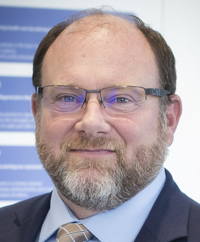Reflections On An Unprecedented Decade In The Cell And Gene Therapy Field
By Michael May, Ph.D., President and CEO and Stacey Johnson, Director of Communications and Marketing, CCRM

Having launched near the beginning of the last decade, Toronto-based CCRM has had a ringside seat to the noteworthy advances in our industry — from 2011 to today. And there have been many.
CCRM is a not-for-profit organization with strategic funding, dedicated infrastructure and specialized business and scientific expertise that works closely with its stakeholder networks to solve the big problems in regenerative medicine and cell and gene therapies. We collaborate with academics to launch new ventures and enable industry by developing advanced manufacturing solutions and providing CDMO services and, consequently, have a good sense of the challenges companies are facing to commercialize their therapies and technologies. We also engage with government to address regulatory and market access issues, and we are scaling emerging companies by catalyzing investment. All of this gives us a unique perspective on what has been important to the global community in the last decade.

BlueRock Therapeutics, notable for the size of its US$225 million Series A financing in 2016, is also working with iPSCs to develop treatments to cure cardiovascular disease (in partnership with the University Health Network in Toronto) and Parkinson’s disease (with New York’s Memorial Sloan Kettering). BlueRock was acquired by Bayer last year in a deal worth another US$600 million.

From a Nobel-winning discovery to a revolutionary tool that has significant implications for science, CRISPR-Cas9 has the ability to edit genes quickly, inexpensively and effectively. CRISPR allows researchers to delete undesirable genetic traits that cause diseases and disorders. There is also the potential to put desirable traits into the human genome. An exciting recent outcome has been the editing of bone marrow cells to treat sickle-cell anemia.
On the flip side, we have Dr. He Jiankui who implanted gene-edited embryos into two women who gave birth to genetically altered girls. He has just been found guilty of conducting “illegal medical practices” and sentenced to three years in prison for his unethical actions – a reminder that we need to maintain strong legal and ethical oversight of our industry.
Of course, the most significant driver of growth and investment in the sector was the approval by the FDA, and subsequent reimbursement in the U.S., of the first (Novartis’ Kymriah) and second (Gilead/Kite’s Yescarta) CAR T-cell therapies as treatment options for certain blood cancers in young patient populations. At the end of 2017, the FDA also approved Luxturna to treat children and adult patients with an inherited form of vision loss that may result in blindness. Luxturna is a gene therapy developed by Spark Therapeutics and the Children’s Hospital of Philadelphia.
In 2019 the FDA approved a second gene therapy, Novartis’ Zolgensma, for spinal muscular atrophy. In contrast to the mesenchymal stromal cell (MSC) products that dominated clinical trials at the beginning of the decade, these products have demonstrated astounding clinical efficacy based on clear modes of action, which underlies their importance in moving the sector forward.
For veterans of the field, this has been a long time coming and the excitement is palpable as a wave of approvals are happening around the world, triggering concerns about the high price and scalability of these therapies.
It is a true sign that an industry is “coming of age” when conference agendas, webinars and investment memos are dominated by manufacturing and scale-up issues. Early in the decade some of us anticipated this would be a major bottleneck to widespread use. In 2016, GE Healthcare and the Government of Canada invested CAN$40 million to build the Centre for Advanced Therapeutic Cell Technologies in partnership with CCRM to industrialize cell manufacturing. Now, companies like Spark Therapeutics, Pfizer and Novartis are building their own manufacturing plants to meet in-house needs and we’re witnessing significant expansion of CMOs and related deal-making (for example, Thermo Fisher Scientific’s acquisition of Brammer Bio and GE Healthcare and Pall being acquired by Danaher).
Realization of the promise of cell and gene therapy has also triggered large strategic partnerships involving (finally!) major biopharma companies and several huge acquisitions (Gilead and Kite Pharma, Roche and Spark Therapeutics, Bristol-Myers Squibb and Celgene, Bayer and BlueRock Therapeutics, Vertex Pharmaceuticals and Semma Therapeutics) over the last few years. At Phacilitate Leaders World, in January of this year, Greg Bonfiglio of Proteus Ventures stated that the global market for cell and gene therapies reached US$6.02 billion in 2019 and the industry is expected to grow to US$35.4 billion in five years, with a CAGR of 21.9 per cent.
While iPSCs have come into their own in the last decade, so have CARs and gene therapies. According to Frances Verter of Cell Trials Data, also a presenter at Phacilitate, CAR trials took off in 2014 and they are now surpassing MSC trials, which, as mentioned above, have not demonstrated similar levels of efficacy against a long list of hyped therapeutic claims. 2019 saw 447 immunotherapy trials; 69 percent were T-cell based and the majority were autologous.
Gene therapies took a severe hit after 18-year-old Jesse Gelsinger died during a clinical trial in 1999, but those fears seem to be behind us. A 2018 article in MIT Technology Review asks if 2017 was “the year of gene-therapy breakthroughs” thanks to reported cures of patients with cancer and rare diseases, and there are other similar headlines. Regardless of future successes and setbacks, cell and gene therapy is likely here to stay.
As stated in Pharma Boardroom, “Since 2010, DealForma has also tracked 120 venture seed and venture rounds in gene therapy, with USD 5 billion raised. Half of that has arrived in the last 18 months. And over USD 3 billion went to companies with only a platform technology or preclinical work — with nothing in the clinic.” AVROBIO, a gene therapy company for rare diseases launched in Toronto in 2016, completed a US$60 million Series B financing round in 2018 to advance multiple gene therapies from its proprietary lentiviral platform and, later in the same year, executed a successful initial public offering on the NASDAQ.
Finally, it is noteworthy that all these advances are compelling countries to think innovatively about their regulatory policies. Highlights of the decade include Japan’s relaxed regulatory pathway for cell and gene therapies, RMAT and Right-To-Try in the U.S., and growing efforts to curb the proliferation of stem cell clinics around the world selling unapproved treatments to patients.
What Can We Expect in the Next Decade?
As one of the hottest sectors in biotech, we will certainly solve or make significant progress on the big problems that challenge the industry.
While the last decade focused on the development of these novel therapies – so called technology push activities – the work of the next decade will have to tackle patient access bottlenecks – aka market pull activities.
For manufacturing, there is still much to be done to lower costs and ensure quality: automation, scalable cell selection, integration of unit operations (with respect to both material and data), media optimization, product (i.e. potency) and process (e.g. real-time, in-line biosensors) and analytics.
The sourcing, processing and transportation of “living therapies” will also require specialized supply chain and logistics support, and the health economics of potential cures must still be fully evaluated.
Importantly, manufacturing, logistics and reimbursement must be optimized with the patient journey in mind, which will likely result in specialized cell therapy pharmacies and clinics to deliver these new therapeutics at scale. The Cell and Gene Therapy Catapult, managing the launch of Advanced Therapy Treatment Centres (ATTCs) across the UK, is at the leading edge of these developments.
With much accomplished, but still many gaps to address, public-private partnerships like CCRM will need to work with academia and industry to address a looming and critical shortage of technical and non-technical highly qualified personnel in the sector.
It’s possible this decade will see cures for many deadly and debilitating non-communicable diseases, and patients will finally benefit from a discovery that happened 60 years ago in Toronto.
